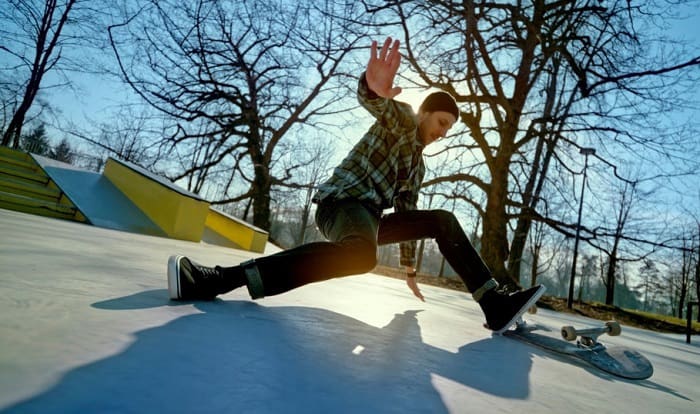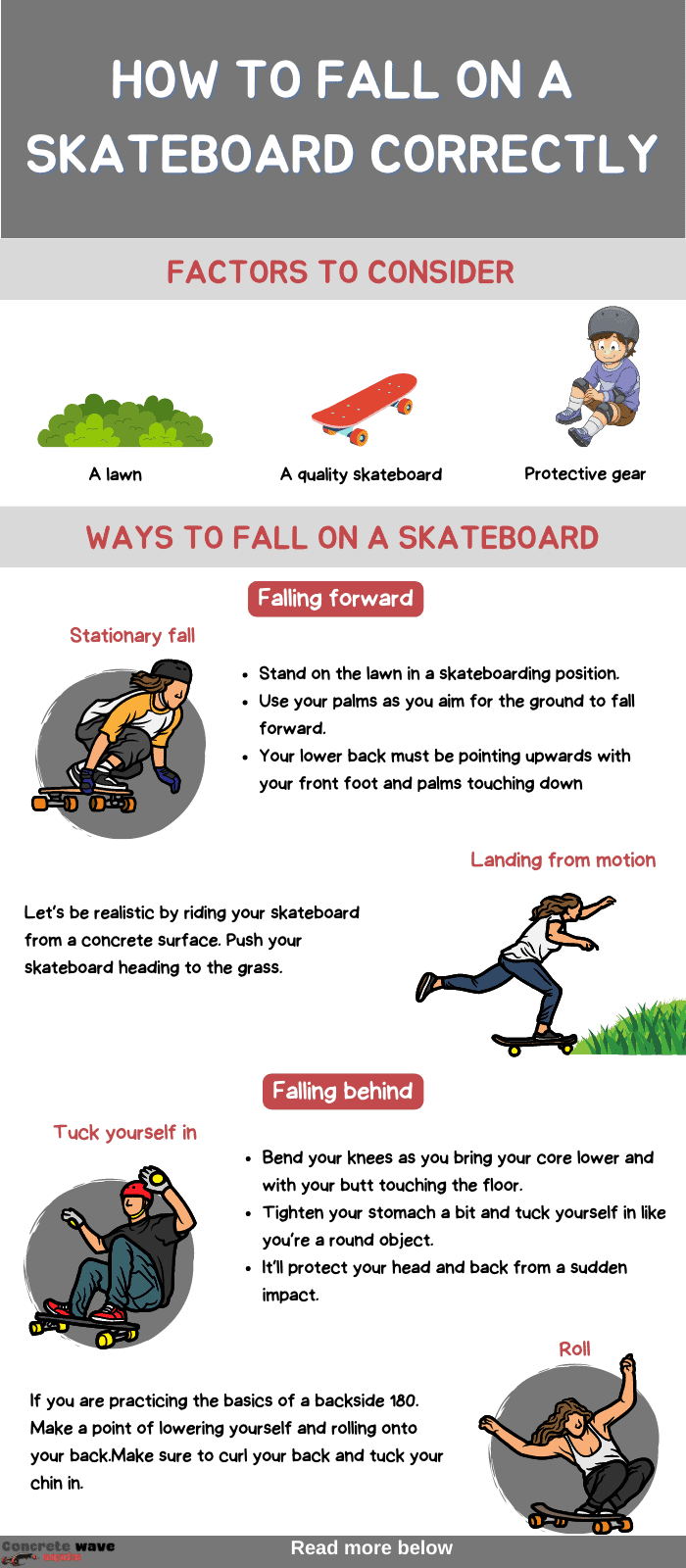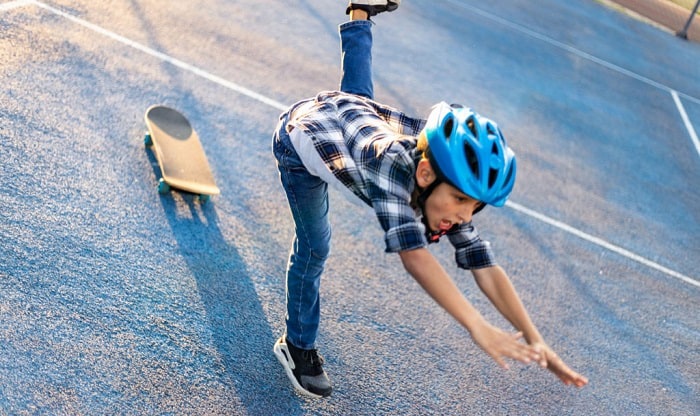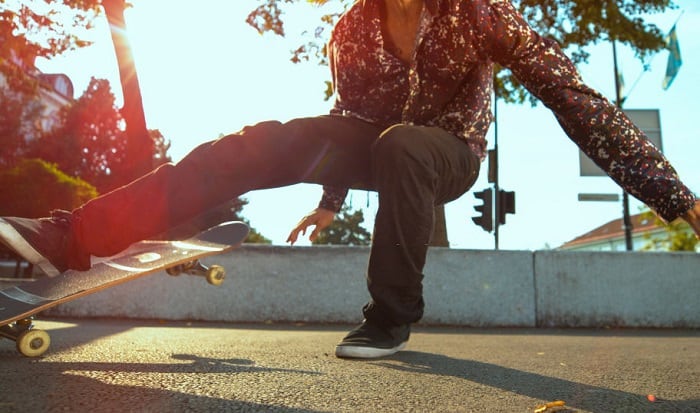Whether you’re a beginner or an experienced rider, the best way to escape skateboard accidents is by anticipating them. The more you fear what will happen around you, the more you tend to be extra careful. However, the anticipation alone may not be enough because of slim chances of meeting mishaps with your skateboard.
With that, let me teach you how to fall on a skateboard correctly. At the end of this tutorial, you’ll be able to establish your course of action should you encounter unfavorable circumstances with your board. Below are the key points of our discussion.
- Bending your arms
- Strengthening your core
- Rolling
Table of Contents
What You Will Need
If new tricks require quality equipment to help you perform well, practicing skateboard falls will even call for more reliable pieces. Thus, prepare the things listed below to make the execution safe and perfect.
A lawn
You don’t necessarily need to practice falling on flat surfaces in your first attempts. The proper way to train your muscles in this skill is by starting on slightly soft grounds.
Between a field of grass and a concrete surface, it’s clear enough that a lawn will hurt less when you fall skateboarding. So, find a space in your yard or car parks where grass is present.
Also, it’s best to practice on a grass space with concrete ground beside it to make your training even more realistic. That way, you can start skating on a solid area and bump the wheels to the grass as you fall safely.
A quality skateboard
If you have several skateboards, pick the most reliable one among them. That board should have the following characteristics:
- A durable deck – When practicing, expect your board to stumble with you, like a genuine accident. But of course, you don’t want to damage its body for real.
- With that, choose a skateboard made with materials like bamboo, maple, fiberglass, or any combination of these. These materials are more likely to contain impact than cheap wood.
- Sturdy trucks – One more board component we need to consider is your truck. Later on, you might try falling off skateboard from a platform a few feet higher than the ground. In that case, your skateboard is more likely to encounter impact from a fall, which means your trucks should be as durable as your deck.
Protective gear
Of course, if you use safety equipment for casual rides, the more you should use them when learning how to fall properly on a skateboard. Make a checklist of the things below.
- A helmet – Head damages are either moderate or severe injuries. These mishaps can happen when you fall hard without protection. So, think of your head as fragile as glass. That way, you’ll do anything to protect it, like wearing an impact-proof helmet.
- Wrist guards – One of our goals in this tutorial is to fall correctly with your hands. However, broken wrists are a common injury among skaters. Wearing wrist guards can help reduce the risk of breaking bones and wrist injuries caused by these instances.
- Knee pads and elbow pads – Your most agile body parts are your knees and elbows. You will bend your knees several times and extend your arms to counter poor balance.
Not only are they vital for stable rides, but are important skateboard falling as well. So, protect them with pads because they are doing most of the work when skateboarding.
Ways to Fall on a Skateboard
Practicing a skateboard fall does not necessarily mean you need to force yourself to experience injuries to call the process successful.
Let me teach you two common ways to execute this skateboarding skill, falling forward and behind. Here are the steps.
Falling forward
- Stationary fall
In this step, you will not need to use your skateboard yet. First, stand on the lawn in a skateboarding position. Next, use your palms as you aim for the ground to fall forward. At this point, your lower back must be pointing upwards with your front foot and palms touching down.
The trick here is to keep your wrists, elbows, and knees bent. Try to keep your limbs loose, as stiff joints can only worsen the situation. Lastly, collapse and roll your body, starting with your dominant arm supported by your shoulder.
- Landing from motion
When your skateboard bumps into something that can stop its momentum with force, it’ll throw you off. So, let’s be realistic by riding your skateboard from a concrete surface. Push your skateboard heading to the grass. And as soon as the wheels stop at the concrete and lawn seam, perform the previous step.
Keep in mind that you might fall in any direction in front of you. So, try not to lose focus to fall correctly.
Falling behind
- Tuck yourself in
At this point, we have to ensure you know how to fall backward. Set your skateboard aside first and stand with the lawn behind you. When you fall behind your skateboard, your instinct will suggest you step your feet on the ground first. But that does not guarantee you’ll regain balance right away.
So, bend your knees as you bring your core lower and with your butt touching the floor. Tighten your stomach a bit and tuck yourself in like you’re a round object. It’ll protect your head and back from a sudden impact.
- Roll
Let’s say you’re practicing the basics of a backside 180. Your feet might miss the board, or you might lose control of it, making you fall back to the ground. Once this circumstance occurs, be sure to lower yourself down and roll onto your back. Make sure to curl your back and tuck your chin in.
Don’t ever reach your arms towards the back. Instead, keep them to the sides.
Pro tips
- Perform regular maintenance check-ups on your skateboard. That way, you get to reduce skateboarding accidents caused by issues on its parts.
- Always find a safe environment for yourself. You don’t need to practice in a congested skating park or a busy road.
- Always use your helmet to guard your head and other safety equipment to avoid being hurt by skateboarding accidents.
Conclusion
Skateboarding is not only about tricks because it’s a sport that requires utmost safety. Falling on a skateboard does not make you less of a rider. The truth is, it happens to all skateboarders, especially when practicing tricks.
Learning how to fall on a skateboard correctly is more of a skill rather than an unfortunate event. So, always remember the few tips I have shared with you as you ride your board with caution.
Go for more fun and safe rides. Did you like this article? Tell us what you think in the comments section.

Hi, I am Charles Harris. I opened this site to write as much as I can about my biggest passion – skateboarding!
I started as a clumsy yet passionate rookie 10 years ago to now a still passionate yet much better skateboarder! But I have to tell you, the whole journey has always been fun and rewarding, indeed not without hardship.





